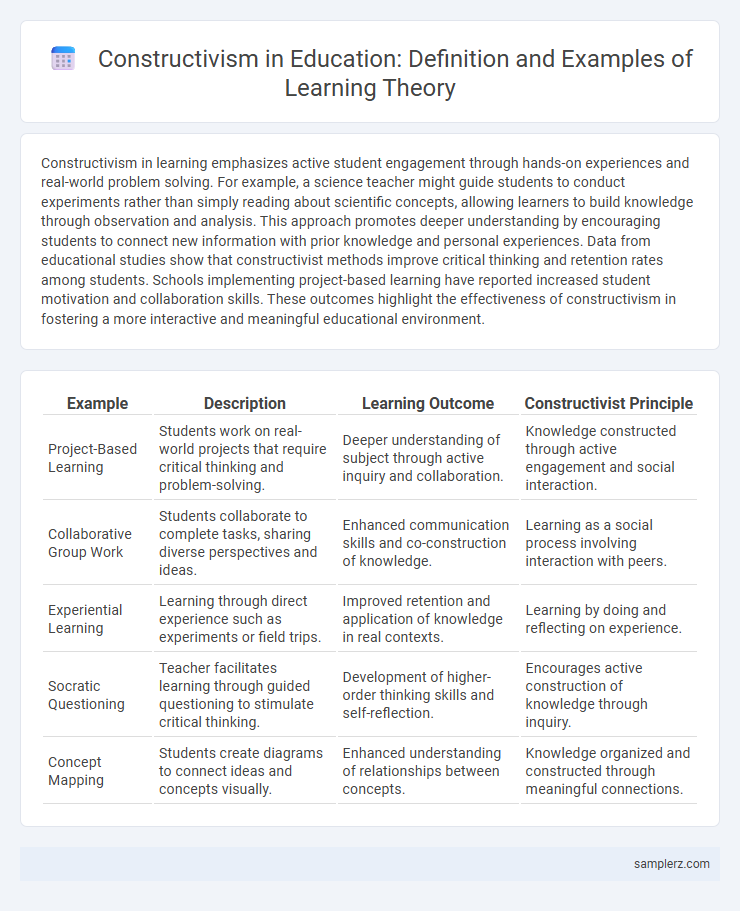Constructivism in learning emphasizes active student engagement through hands-on experiences and real-world problem solving. For example, a science teacher might guide students to conduct experiments rather than simply reading about scientific concepts, allowing learners to build knowledge through observation and analysis. This approach promotes deeper understanding by encouraging students to connect new information with prior knowledge and personal experiences. Data from educational studies show that constructivist methods improve critical thinking and retention rates among students. Schools implementing project-based learning have reported increased student motivation and collaboration skills. These outcomes highlight the effectiveness of constructivism in fostering a more interactive and meaningful educational environment.
Table of Comparison
| Example | Description | Learning Outcome | Constructivist Principle |
|---|---|---|---|
| Project-Based Learning | Students work on real-world projects that require critical thinking and problem-solving. | Deeper understanding of subject through active inquiry and collaboration. | Knowledge constructed through active engagement and social interaction. |
| Collaborative Group Work | Students collaborate to complete tasks, sharing diverse perspectives and ideas. | Enhanced communication skills and co-construction of knowledge. | Learning as a social process involving interaction with peers. |
| Experiential Learning | Learning through direct experience such as experiments or field trips. | Improved retention and application of knowledge in real contexts. | Learning by doing and reflecting on experience. |
| Socratic Questioning | Teacher facilitates learning through guided questioning to stimulate critical thinking. | Development of higher-order thinking skills and self-reflection. | Encourages active construction of knowledge through inquiry. |
| Concept Mapping | Students create diagrams to connect ideas and concepts visually. | Enhanced understanding of relationships between concepts. | Knowledge organized and constructed through meaningful connections. |
Real-World Problem Solving in the Classroom
Constructivism in education emphasizes students actively engaging with real-world problem solving to construct knowledge through experience and reflection. For example, learners might collaborate on designing sustainable urban gardens, integrating science, math, and social studies concepts to address environmental challenges. This approach fosters critical thinking, creativity, and practical application of academic content, enhancing meaningful learning outcomes.
Collaborative Group Projects for Deeper Understanding
Collaborative group projects in constructivist learning environments promote active knowledge construction by encouraging students to engage in dialogue, share diverse perspectives, and co-create solutions. This approach enhances critical thinking and deeper comprehension through social interaction and the negotiation of meaning. Research shows that peers working together in structured tasks improve retention and the ability to apply concepts in real-world scenarios.
Inquiry-Based Science Experiments
Inquiry-based science experiments exemplify constructivism by actively engaging students in the process of exploring scientific concepts through hands-on investigation and critical questioning. This approach emphasizes the construction of knowledge as learners formulate hypotheses, conduct experiments, and analyze results, fostering deeper understanding and retention. By facilitating collaborative problem-solving and reflective thinking, inquiry-based learning promotes the development of scientific reasoning and inquiry skills essential for lifelong learning.
Student-Led Discussions and Reflections
Student-led discussions in constructivism empower learners to actively engage with content by sharing perspectives and constructing knowledge collaboratively. Reflection activities encourage students to critically analyze their understanding and connect new concepts with prior experiences. This approach fosters deeper comprehension and promotes metacognitive skills essential for lifelong learning.
Project-Based Learning in Curriculum Design
Project-Based Learning (PBL) exemplifies Constructivism in education by engaging students in hands-on, real-world projects that promote active knowledge construction and critical thinking. This curriculum design encourages collaboration, problem-solving, and reflection, enabling learners to connect theory with practice and develop deeper understanding. Educators incorporating PBL create dynamic learning environments that foster student autonomy and intrinsic motivation.
Using Case Studies to Build Critical Thinking
Using case studies in education promotes constructivism by encouraging students to actively engage with real-world problems and develop their critical thinking skills. This method allows learners to analyze complex scenarios, draw connections between theory and practice, and construct their own understanding based on evidence. Case-based learning fosters collaboration and reflection, essential components of constructivist pedagogy.
Role-Playing Scenarios for Active Engagement
Role-playing scenarios in constructivist learning environments promote active engagement by allowing students to immerse themselves in real-world contexts, facilitating deeper understanding through experiential participation. These scenarios encourage learners to construct knowledge collaboratively while developing critical thinking and problem-solving skills. Research shows that role-playing enhances retention and motivation by linking theoretical concepts to practical applications in diverse subjects such as social studies, language arts, and science.
Concept Mapping to Visualize Knowledge Construction
Concept mapping in constructivist learning enables students to visually organize and represent relationships between concepts, enhancing comprehension and retention. This technique supports active knowledge construction by encouraging learners to connect new information with prior understanding. By mapping out ideas, students develop deeper critical thinking skills and foster collaborative learning environments.
Flipped Classroom: Empowering Student Exploration
Flipped Classroom methodology transforms traditional education by assigning instructional content as homework and utilizing class time for active student exploration and collaboration. This constructivist approach encourages learners to engage deeply with materials through problem-solving activities, fostering critical thinking and meaningful understanding. Research shows that students in flipped classrooms demonstrate improved academic performance and higher motivation compared to conventional teaching methods.
Integrating Technology for Interactive Learning
Constructivism in education emphasizes active learning through experience and reflection, with technology playing a crucial role in facilitating this process. Integrating tools like interactive simulations, virtual labs, and collaborative platforms enables students to explore concepts deeply, construct knowledge, and engage in problem-solving activities. These technology-driven experiences foster critical thinking and personalized learning pathways, aligning with constructivist principles.

example of Constructivism in learning Infographic
 samplerz.com
samplerz.com